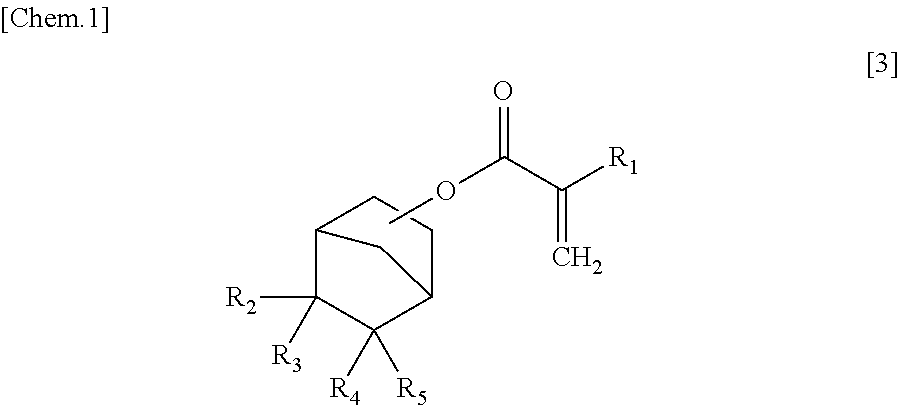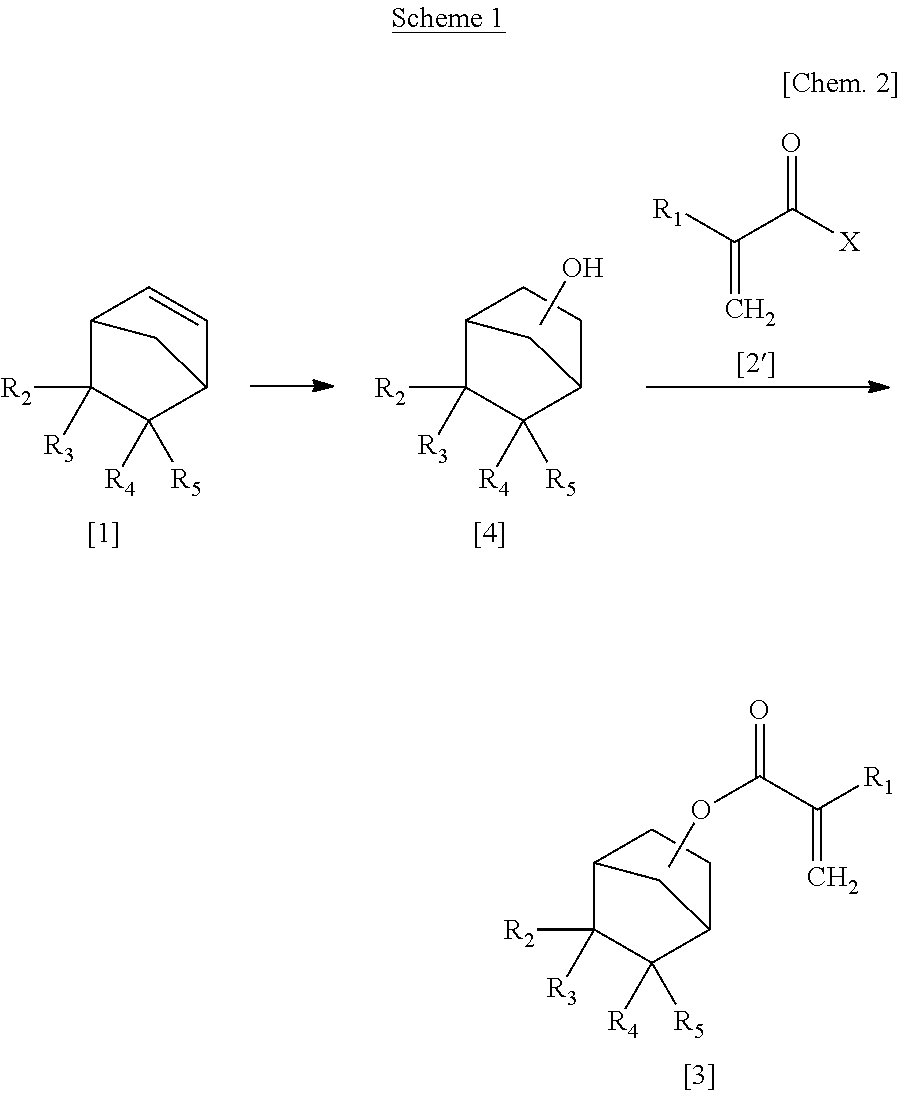Process for Producing Alpha-Substituted Norbornanyl Acrylates
a technology of alpha substitution and norbornanyl acrylate, which is applied in the preparation of carboxylic acid esters, chemistry apparatus and processes, and organic chemistry, etc., can solve the problems of low conversion rate of reaction and reaction progress
- Summary
- Abstract
- Description
- Claims
- Application Information
AI Technical Summary
Benefits of technology
Problems solved by technology
Method used
Image
Examples
example 1
[0059]
[0060]Into a 1-L three-neck flask with a reflux condenser attached to a top portion thereof, were placed 3.0 g of camphorsulfonic acid, 86.7 g of acrylic acid and 300 g of 5-(1,1,1-trifluoro-2-hydroxyl-2-trifluoromethyl-propyl)-norbornene as raw material. The flask was then heated in an oil bath of 120° C. After a lapse of 20 hours, the composition of the resulting reaction solution was analyzed by gas chromatography. The reaction conversion rate was 98%. The total amount of the mixture of isomers of a target α-substituted norbornanyl acrylate was 72% (selectivity: 73%). There were also detected, as impurities, 19% of 5,5-bis(trifluoromethyl)-4-oxatricyclo[5.2.1.03,8]decane derived from intramolecular cyclization of the raw material (selectivity: 20%), 2% of the 5-(1,1,1-trifluoro-2-hydroxyl-2-trifluoromethyl-propyl)-norbornene raw material and 4% of addition compound of one acrylic acid molecule to a vinyl moiety of the acrylate product (as excessive addition product) (select...
example 2
[0070]Into a 1-L three-neck flask with a reflux condenser attached to a top portion thereof, were placed 3.0 g of methanesulfonic acid, 104 g of methacrylic acid and 200 g of 5-(1,1,1-trifluoro-2-hydroxyl-2-trifluoromethyl-propyl)-norbornene. The flask was then heated in an oil bath of 120° C. After a lapse of 8 hours, the composition of the resulting reaction solution was analyzed by gas chromatography. The total amount of the mixture of isomers of a target α-substituted norbornanyl acrylate was 78%. There were also detected, as impurities, 20% of 5,5-bis(trifluoromethyl)-4-oxatricyclo[5.2.1.03,8]decane derived from intramolecular cyclization of the raw material (as cyclization product) and 2% of the 5-(1,1,1-trifluoro-2-hydroxyl-2-trifluoromethyl-propyl)-norbornene raw material.
[0071]The reaction solution was cooled, followed by adding thereto 300 mL of 5% aqueous sodium hydroxide (NaOH) solution while cooling. The aqueous phase was removed from the resulting solution. After that,...
example 3
[0072]Into a 100-mL two-neck flask with a reflux condenser attached to a top portion thereof, were placed 1.0 g of camphorsulfonic acid, 17.2 g of methacrylic acid and 50 g of 5-(1,1,1-trifluoro-2-hydroxyl-2-trifluoromethyl-propyl)-norbornene. The flask was then heated in an oil bath of 120° C. After a lapse of 8 hours, the composition of the resulting reaction solution was analyzed by gas chromatography. The reaction conditions, the reaction conversion rate and the selectivity of the target compound of each of Examples 2 and 3 are indicated in TABLE 2.
PUM
| Property | Measurement | Unit |
|---|---|---|
| Reaction temperature | aaaaa | aaaaa |
| Temperature | aaaaa | aaaaa |
| Temperature | aaaaa | aaaaa |
Abstract
Description
Claims
Application Information
 Login to View More
Login to View More - R&D
- Intellectual Property
- Life Sciences
- Materials
- Tech Scout
- Unparalleled Data Quality
- Higher Quality Content
- 60% Fewer Hallucinations
Browse by: Latest US Patents, China's latest patents, Technical Efficacy Thesaurus, Application Domain, Technology Topic, Popular Technical Reports.
© 2025 PatSnap. All rights reserved.Legal|Privacy policy|Modern Slavery Act Transparency Statement|Sitemap|About US| Contact US: help@patsnap.com



